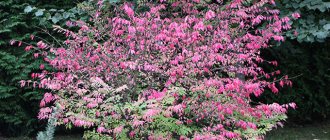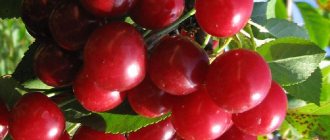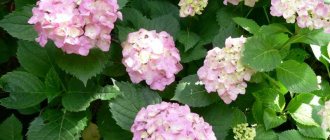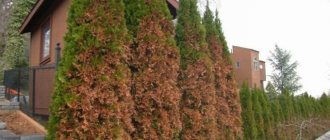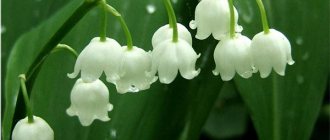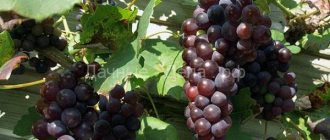Useful properties of viburnum
Viburnum viburnum, which often grows in the far corner of our garden or on the outskirts of the vegetable garden, is a quite useful plant and can have a positive effect on the human body . Its fruits are rich in iron, ascorbic acid, pectin, valeric acid, contain various Z-active substances, and also have preventive and medicinal properties. Thus, from them it is possible to prepare medicines against anemia, diseases of the nervous system, hypertension, as well as against colds, which so often “attack” a person.
In order to preserve viburnum fruits in a form suitable for consumption and to ensure that they retain their beneficial properties, the berries are ground with sugar, stored frozen or simply in water . It is not recommended to boil them or heat them for a long time; this can destroy anthocyanins and other biologically active substances, which will significantly reduce the value of the product.
Viburnum viburnum - storage conditions
The fruits of this valuable crop hang on the branches for a long time even after severe frosts, but it is better to harvest them before mid-October. With the advent of electrical appliances, the number of ways to freeze or dry berries has increased significantly. Let's consider options for winter storage of red viburnum berries:
- Hang clusters of fruits in bunches in attics, balconies, and dry basements.
- Place the berries in cardboard boxes, cover with sheets of paper and place in a dry cellar.
- Store in paper bags or enamel containers on the bottom shelf of the refrigerator.
- Washed and dried viburnum fruits are suitable for freezing. First, the berries scattered in one layer are cooled and then placed in containers.
- Viburnum can be dried in an electric dryer at a temperature not exceeding 50-60°C.
Growing viburnum in the garden
Understanding the beneficial properties of this wonderful bush and noticing all its beauty, many gardeners plant viburnum in their summer cottages and gardens. It is required to be able to properly handle the bush so that it is strong throughout its life and bears fruit generously.
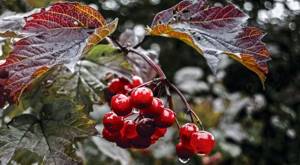
Viburnum viburnum is not a very demanding plant, but it requires some tricks when growing. Thus, in nature, the shrub most often grows in moist places, but in cultivated gardens it prefers drier soils. The soil must be prepared, as for other garden plants, and the area with low groundwater levels must be correctly identified.

Although viburnum seedlings obtained through vegetative propagation begin to bear fruit much earlier, already in the second year after planting, experts recommend gardeners to grow planting material from seeds.
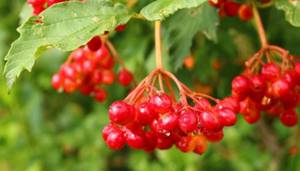
Varieties of Viburnum
There are many interesting varieties of this culture. The Viburnum Roseum described above is a sterile plant, but during the period of prolonged flowering it looks incredibly elegant on the site. In the list below we offer for consideration fruit and ornamental varieties with excellent characteristics that can easily be used in the country:
- Viburnum Nanum
is a shrub with a low trunk up to 1 m, lacy leaves, with a reddish tint when young, flowering rarely occurs. Recommended for arranging rock gardens, Japanese gardens, and low borders. - Viburnum viburnum Aureum
- golden-yellow foliage, bushes up to 2 m tall. The annual growth of the plant is up to 15 cm, excellent winter hardiness, the fruits are black and shiny. - Viburnum Xanthocarpum
is a yellow-fruited, relatively rare variety, bush height up to 1.5 m, crown width about 2 m. - Kalina Maria
is a fruit variety with sweetish-sour and slightly tart berries up to 0.6 g. Tasting score – 4.2. - Viburnum ordinary Pomegranate bracelet
is a fruit variety, high yield up to 15 kg, berries up to 1 g, slightly bitter and pleasant taste. - Zholobovskaya
is a fruit variety, the berries are slightly bitter, almost sweet, for universal use.
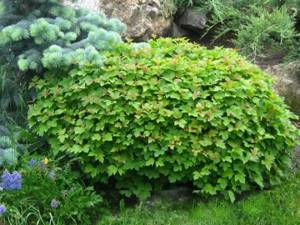
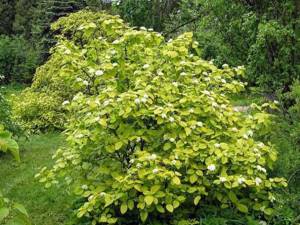
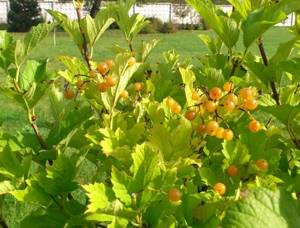
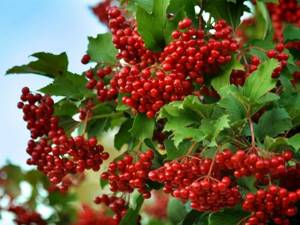
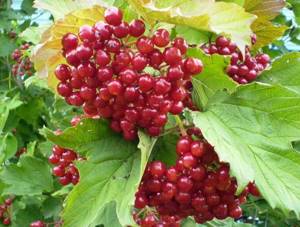
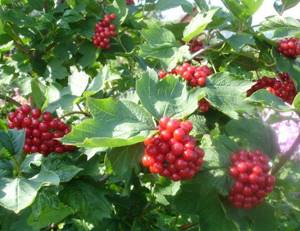
Growing viburnum from seeds
Seeds must be isolated from the best plant fruits, determined by yield, size, and taste. The resulting seeds can be planted in a nursery in the autumn of the year in which they were collected, but in this case, seedlings will have to wait quite a long time. For more information about planting shrubs in the fall, see the article “Autumn planting of shrubs and trees in the garden.” Germination will begin around the end of summer next year. First, a small root will appear, and the seed itself with its shell will come to the surface. In this state, small seedlings go to winter and only in spring the cotyledons will be freed from the seed covers and begin to grow in height.
If viburnum needs to be grown in a shorter time, then the stratification method is used. The seeds are placed in a nylon bag and, as such, placed in damp sawdust or moss. It takes two months to store the seeds at a temperature of +19+23 degrees Celsius. Next, the seedlings are placed in a cooler place, a basement or refrigerator, where the temperature should not exceed +5 degrees Celsius. The period of detention is one month. Ready seedlings are deepened into the ground so that the subcotyledon remains above the soil surface. In the intermediate period, February-March, the seedlings continue to develop and are gradually freed from the covers. Thus, seedlings are formed. They reach a height of 5-8 centimeters and have a pair of leaves on the trunk. In early May, the finished seedlings are transferred to a nursery and planted in open ground in the spring of next year.
How to form common viburnum?
This crop can be grown as a slender tree or as a spreading shrub. Decorative bushes are formed as follows:
- A young seedling is left with only 2-3 above-ground buds after planting.
- When the height reaches 30 cm, pinch off the tops.
- Every year, only the most powerful replacement shoots are left, pinching them by 30%, and the rest of the shoots are cut out.
- The shoots of an adult bush are destroyed. Pruning viburnum in spring consists of removing dry and diseased branches, healthy shoots are shortened to the desired height.
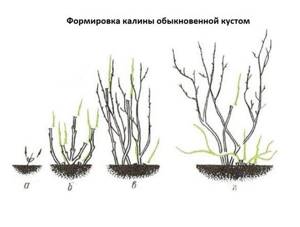
Viburnum common - standard
Due to the large number of annual root shoots, maintaining a plant in the form of a tree is a little more difficult. The standard formation of common viburnum is as follows:
- For the first couple of years, pruning is not done, waiting for good rooting.
- Only the most powerful vertical shoot is left for the third season.
- Next, the shoots are cut out, branches below 30-40 cm on the trunk are removed.
- When the viburnum reaches an ordinary height of one and a half meters, the growth point is pinched.
- The crown is formed from the best lateral branches.
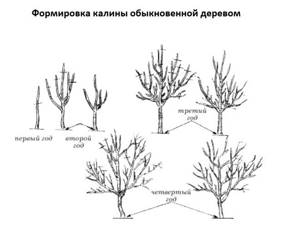
Vegetative propagation of viburnum
Sometimes one gorgeous viburnum bush in a garden plot is not enough, and the owners decide to propagate such a beautiful and useful plant. This can be done by layering or cuttings. Such material should be prepared in early July. The shoots are cut with pruning shears, the cuttings are divided into segments, the lower leaves are removed and the upper ones are halved, halving their surface. The cuttings are tied into a bundle and placed in a specially prepared solution, 100 grams of heteroauxin per 1 liter of water. The depth of immersion of cuttings in the solution is no more than two centimeters. It takes a lot of effort to prevent the solution from getting on the leaves. After 10-15 hours, the cuttings can be removed from the solution, rinsed with water and planted in a greenhouse or nursery.
Rooting viburnum at home
Yes, it is possible to root cuttings at home by planting them in flower pots. To do this, you will need prepared soil - turf soil, sand and humus, proportions 3:1:1. This mixture should occupy 2/3 of the volume of the pot for planting. Next, pour river sand on top of the soil, a layer of about three centimeters, moisten it generously and plant the cuttings to a depth of 2 cm. Such seedlings need to be covered with polyethylene or simply an inverted jar, thereby creating a greenhouse. It is advisable to spray the inside of the greenhouse with water.
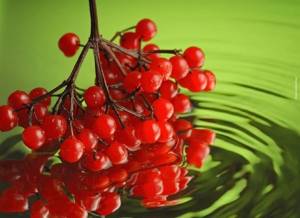
Cuttings that have taken root are put into a cool basement in November, along with the pot. The soil is slightly moistened. The cuttings must be kept in this condition and at a certain temperature until February, then transferred indoors. In May, together with a lump of earth from a pot, they are planted in open ground. You can extend the rooting period of cuttings for another year, then they will be much stronger and can easily withstand a variety of weather conditions, heat or frost. In this case, they must be left without covering with film or glass for storage until next year.
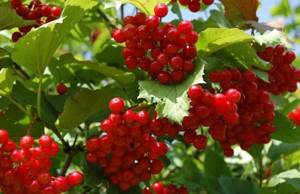
Transplanting viburnum
The optimal period for this operation is spring or autumn. Agrotechnical measures are carried out according to the following scheme:
- The transplant site is dug up.
- The size of the hole is 0.5x0.5 m.
- In order for the red viburnum plant to develop more intensively, you need to add half a bucket of humus and up to 1 tbsp. ash.
- The transplanted bush is dug around a radius of 30 cm.
- It is advisable to remove the viburnum with a lump of soil.
- The bush is transferred to a new hole.
- The hole is filled with soil, compacted, watered, and mulched.
Planting viburnum cuttings
The cuttings are planted in open ground at a distance of 3-4 meters from each other, in soil rich in humus and protected from dry winds. The finished cuttings are planted 6-7 centimeters deeper than the root collar. In order for the root system, which had developed even before planting in the ground, to remain strong and constantly develop, seedlings must be placed in holes about 60 cm deep and 80 cm in diameter. When planting, the upper part of the holes is filled with the same soil as on the site, then it is watered abundantly and mulched with humus.
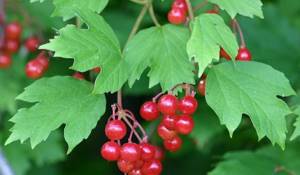
How to plant viburnum in spring: a step-by-step guide
You can plant viburnum using cuttings or seeds, but there is no guarantee that the seed will germinate. You can plant annual or biennial seedlings. It is best to plant in early spring, from mid-March to mid-April.
Did you know? Viburnum berries remove radioisotopes from the body.
Selecting a location
In spring, viburnum should be planted before the leaves bloom. The soil should be neutral or slightly acidic. In order for viburnum to bloom and bear fruit every year, you need to choose a site for planting where the water does not stagnate, there is good lighting and there is no strong wind, since in winter the plant can freeze and die.
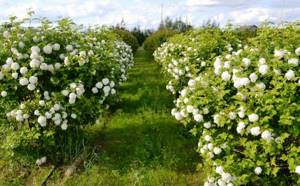
Soil preparation
It is best to start preparing the soil a month before planting the plant; it must be cleared of weeds and fertilized. The fertilizer must contain potassium and phosphorus. Before planting the plant, loosen the soil and remove weeds. The size of the planting hole depends on the volume of the root system of the cutting.
Important! Viburnum is not suitable for sandy and peat soil.
One-year-old seedlings need a hole 20–25 cm deep and 25–30 cm wide. Two-year-old seedlings need 40–50 cm in depth and 50–60 cm in width. The plant grows better in neutral and slightly acidic soils.
Planting viburnum in the ground
In order for the shrub to grow better and bear fruit in the future, you need to follow some rules.
Step by step guide:
- Plant bushes in groups of 2–3 bushes, the distance between groups is 3 m.
- Saplings with bare roots need to be planted after certain preparation: place the roots for 30–40 minutes. into the water, then cut off the damaged ones and shorten the remaining ones by 15–20 cm. At the bottom of the hole, make a small mound from the top layer of soil, place the cutting on it, freely distribute the roots and cover it with earth.
- Seedlings with a closed root system are buried no more than 5 cm from the root collar.
- The soil should be added to the roots slowly, slightly pulling the seedling up. The soil should take up all the empty space between the roots.
- After planting, compact the soil, make a hole around the plant and water it.
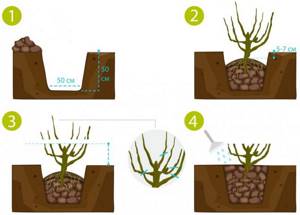
Plant care
Viburnum is looked after like most plants in the garden - they fight nearby weeds, loosen the soil in rows and between rows, mulch the holes and ensure soil moisture by watering . It is also necessary to remember about trimming dry branches from the trunk. Once every 7-9 years, the bush should be lightened, that is, the thickened crown should be thinned out. It is not recommended to shorten shoots.
necessary to fight pests, constantly caring for the bark and leaves of the plant. Most often, viburnum is attacked by aphids, which can be removed using a decoction of tobacco and green soap, a solution of 40 g per 10 liters of water. Try to spray in a timely manner.
Viburnum can grow on plain soil, but in order for its bush to be beautiful and fertile, it still needs to be fed. Fertilization of the soil occurs along with the mulching process; compost, peat, and humus are added to the soil.
Pruning viburnum
Once every 7 years the plant requires pruning. This is due to the fact that the trunks of the bush retain their vital activity for about 30 years, and over time the crown thickens so that it becomes problematic to collect fruits, and their quality deteriorates. The shrub will rejuvenate with the removal of a third of its branches. It is important to leave the most developed young stems intact.
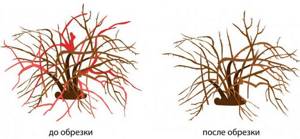
All old, dry and competing branches are removed immediately.
How to trim
There are no strict rules for pruning viburnum. Old and shriveled branches should be removed. You can also adjust the height of the plant by cutting the shoots at a height of about 1.5 m to make harvesting easier. Branches that are too thin and broken, as well as those that grow inside the crown, must be removed. After pruning, be sure to treat the affected branches with garden varnish.
Find out more about the medicinal properties and contraindications of viburnum flowers.
Tree pruning
It will take a lot of effort and time to give viburnum the shape of a tree. To do this, you need to choose the thickest and straightest shoot coming from the root. It will be used as a trunk. The remaining basal shoots are cut off. The remaining trunk needs to be fertilized twice a year and fed regularly. At a height of 45 cm, all side branches and shoots are cut off, leaving one trunk.
Above the mark for creating a trunk, the branches are not touched and are given time to grow and thicken. Further, depending on the wishes of the gardener, the crown of the viburnum can be given any desired shape. It takes about 3 years to form the trunk and crown.
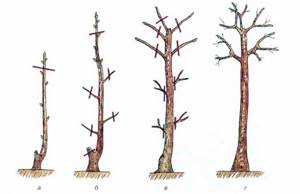
Growing and forming a trunk: a - first year; b - first and second; c - second and third year; d - third and fourth year.
Bush pruning
For such pruning, you need to select about 5-7 skeletal trunks and trim the rest around them. The side branches on the remaining trunks are cut off. This should happen in late autumn.
In summer you need to make a modeling haircut:]
- Cover the bush with a net.
- Use it to give it the desired shape.
- Cut off all branches that extend beyond the mesh.
- If necessary, after a week, correct the shape and outline the silhouette more clearly. You no longer need a mesh for this.
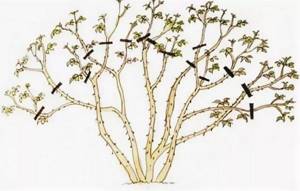
Corrective haircuts can be carried out up to 3 times a season.
When to prune
The timing of pruning depends on its purpose. It should be done infrequently so that the plant can rest and gain strength.
There are three types of pruning viburnum:
- sanitary;
- thinning;
- formative.
Each of them must be done at the right time so as not to harm the plant.
Pruning in spring
Usually it is recommended to prune viburnum in the first weeks of March. Sanitary pruning, performed to remove dry and damaged branches, can take place at any time of the year. In early spring, formative and thinning pruning can also be done.
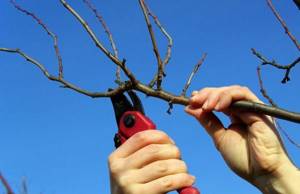
They must be performed before sap flow begins.
Pruning in autumn
Viburnum branches can be pruned after all the leaves have fallen. During this period, you can carry out a sanitary haircut. Remove all non-viable branches and branches growing inward until healthy tissue is removed. You can also carry out formative pruning in the fall. It is performed when the viburnum is at rest - after leaf fall.
Harvesting from a viburnum bush
When the main result of planting viburnum on the site has been achieved and the bush is showered with bright red bunches of berries, you need to think about harvesting. This process should also be carried out in a very timely manner, otherwise the berry may lose its juice, and, accordingly, its taste and beneficial properties. Also, part of the harvest is lost due to strong winds and birds that peck the berries. The bunches should be cut very carefully; breaking is not recommended, otherwise you can ruin next year's harvest by accidentally catching the buds . Harvesting takes place in mid to late September.
Pros of planting viburnum
Healing properties
Viburnum contains a huge amount of vitamins and minerals that strengthen the immune system. Everyone knows about this, and doctors have repeatedly confirmed this. Fresh berries are an excellent way to lose weight. They are consumed on an empty stomach or together with other fruits. The berry is also a diuretic and diaphoretic. It must be used during colds and other infections. The fluid is abundantly removed from the body and all harmful toxins along with it.
Viburnum contains viburnin, which plays the role of an analgesic, increases appetite, gastrointestinal function and constricts blood vessels, as well as valeric acid, which calms the excited nervous system. For this reason, the berry is useful for those people who experience constant stress or even become depressed. Regular consumption of viburnum will reduce cholesterol levels in the blood, thereby improving vascular permeability. And this directly affects the normalization of blood pressure and the functioning of the cardiac system.
Varieties for planting
Growing viburnum turns into a hobby for many people. This beautiful bush with a lot of useful properties is liked by summer residents for its unpretentiousness and imperious appearance. Therefore, we decided to talk a little about what types of viburnum there are that are suitable for planting in cultivated areas:
- Shukshinskaya . The variety is resistant to pests and plant diseases, tolerates winter frosts well and is not damaged by spring temperature changes. The bush is tall, vigorous, with large leaves. The fruits are of good taste, slightly bitter, spherical, crimson-red in color. The average weight of a bunch of fruits is 0.75 g. Shukshinskaya viburnum bears fruit regularly and can produce up to 8 kg of harvest per season;
- Ulgen. A tall variety, sometimes up to four meters, multi-stemmed. The fruits ripen in mid-September, the berries are medium-sized, weighing up to 0.75 g, bright red in color. The taste is classic, with a slight bitterness. The yield of the Ulgen variety is up to 10 kg, the period is every year up to 20 years in a row. The variety is self-sterile, but is pollinated by any variety of Viburnum;
- Zholobovskaya . A frost-resistant variety that is not susceptible to pests or diseases. Productivity is about 4.5 kg per bush, the berry is bright red. bitterish, average weight up to 0.55 g. Zholobovskaya viburnum is self-fertile, pollinated by any varieties of viburnum;
- Zarnitsa. A technical variety resistant to weather conditions, diseases and pests. Large fruit, average weight 0.8 g, yield up to 11 kg per bush. A durable variety that can only be pollinated by other varieties of viburnum;
- Taiga Rubies. A strong variety that easily copes with frost, any pest and disease. The fruits are pleasant to the taste, with a bitter taste, small, weighing about 0.5 g. The yield is high, up to 11 kg. The shrub is durable, capable of being pollinated by all varieties of viburnum;
- Souzga. A technical, winter-hardy variety that is not afraid of pests and diseases. The average berry weight is 0.65 g, the yield is up to 12 kg per bush. Souzga is pollinated only by other varieties; the fruits ripen late, at the end of September.
What kind of viburnum to grow in the country
Of course, first of all, gardeners in response to this question will remember the decorative types of this crop. And these are various varieties of red viburnum, and viburnum gordovina, and folded, and Buryat, and three-lobed, and laurel-leaved...
Even ordinary viburnum is very impressive in the garden, especially in spring due to its snow-white inflorescences, and also in autumn and winter due to its bright leaves and fruits. And the decorative forms of this tree are distinguished by especially beautiful foliage (there are even variegated types), large numerous flowers and unusual fruits of different colors (yes, viburnum berries are not only red, but also pink, orange, black, dove-blue).
- Viburnum Buldenezh - photo, description, planting, care and reproduction
Everything you wanted to know about growing ornamental viburnum Buldenezh.
Our gardeners especially love the decorative variety of viburnum (also known as red) with the romantic name Snow Globe (Buldenezh, Roseum). It blooms for about a month at the beginning of summer - snow-white sterile flowers are collected in large spherical inflorescences.
Among other decorative species and varieties of viburnum for decorating a suburban area, we can recommend:
- Compactum is a variety of common viburnum with fragrant white-pink flowers and bright red fruits.
- Kristy (Kristy D.) is a variety of common viburnum with variegated leaves.
- Xanthocarpum is a variety of viburnum with yellow fruits.
- Viburnum folded (Japanese) - a species with a pyramidal bush shape and abundant inflorescences of white or soft pink color. Popular varieties are Pink Beauty, Kilimandjaro, Cascade, Watanabe, Mariesi.
Viburnum is usually planted on a site either as a tapeworm or in groups with other flowering and ornamental deciduous shrubs. It is also good for creating hedges.
And viburnum is not only distinguished by its beauty, but also by its great benefits (one of its types, by the way, is called useful viburnum).
Thus, the berries of this plant have a unique vitamin and mineral composition - only vitamin C in viburnum is twice as much as in lemon! The berries also contain significant quantities of vitamins B3, A, K, B9 and E; molybdenum, magnesium, manganese, selenium, copper, iron, carbohydrates, organic acids, glycosides, tannins...
Thanks to such a rich content of useful substances, the fruits (berries) of viburnum have long been used in folk medicine. Thus, in the form of a collection, they are used as a vitamin remedy, and also as an intensifying contraction of the heart muscle, a diuretic, a diaphoretic, a disinfectant for respiratory infections, and a sedative for insomnia and neuroses.
In folk and scientific medicine in different countries, by the way, not only the fruits of viburnum are used, but also its bark, seeds, leaves, and young twigs. Moreover, the use of various decoctions, infusions, and extracts of this plant material is used for a wide variety of diseases - from headaches or toothaches and diarrhea to epilepsy and atherosclerosis. Of course, in case of serious illnesses, before self-medicating with folk remedies from viburnum, a mandatory consultation with your doctor is necessary.
Viburnum fruits are also actively used in cooking. The tasty and healthy bright red berries of this plant ripen in August-September, but they are collected only after the first frost, then their taste becomes less tart and not so bitter.
Viburnum is used to make homemade wine, compote, preserves and jams, liqueurs, tinctures, jelly, marmalade, pie filling, and seasonings for meat dishes. Moreover, the berries are used both fresh, dry or frozen. Moreover, even vinegar is made from viburnum juice, and its seeds, which have a tonic effect, are sometimes used as a coffee substitute.
There are special fruit varieties of viburnum of domestic selection that have proven themselves well in the middle zone and are distinguished by a pleasant aroma and sweet and sour taste with a slight bitterness: Red Bunch, Vigorovskaya, Red Coral, Maria, Garnet Bracelet, Ulgen, Taiga Ruby, Zholobovskaya.
What else is viburnum useful for in the country? Because she is a good honey plant. For one and a half months (starting in June), the plant provides nectar and pollen to honey bees.
Viburnum is also valued in reclamation plantings as a reliable soil-protective crop.
Ink is also made from the fruits of the viburnum, homemade paint for fabrics is made from the bark and leaves, and pipes are made from its flexible trunks.

